The cell culture market is estimated to be valued at USD 25.27 Bn in 2025 and is expected to reach USD 55.90 Bn by 2032, growing at a compound annual growth rate (CAGR) of 12.0% from 2025 to 2032.
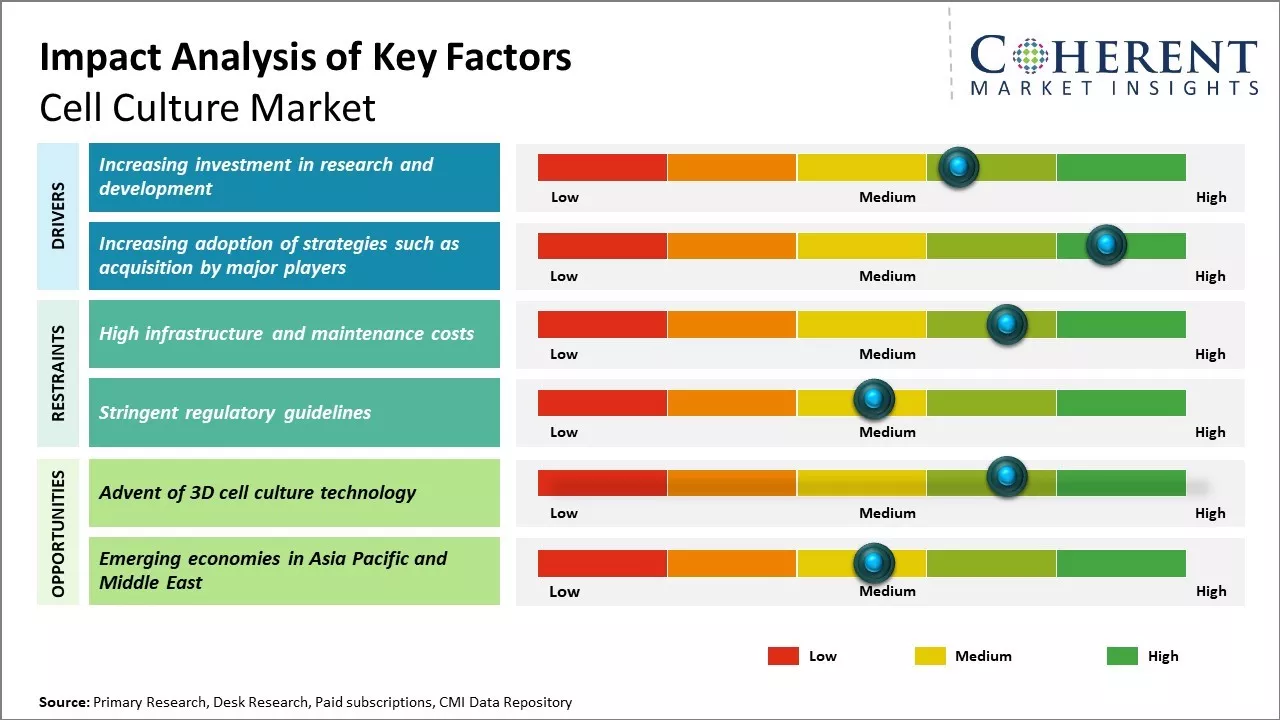
Discover market dynamics shaping the industry: Download Free Sample
The cell culture market is expected to witness positive growth over the forecast period. Technological advancements in cell culture media formulations which help in optimal cell growth are expected to drive the market. Growing demand for therapeutic antibodies for treatment of chronic diseases and increased R&D investment in cell-based research are some other factors expected to support the growth of this market. With increasing development of advanced therapeutics, demand for improved cell culture technologies for effective production is also expected to increase. This will likely provide new opportunities for players in this market in the coming years.
Increasing investment in research and development (R&D)
Increasing investment by key market players in research and development for the development of cell culture products is expected to drive the growth of the global cell culture market over the forecast period. For instance, on July 27, 2021, Pall Corporation, a global supplier of filtration, separations, and purification products, announced that the company along with Cytiva, a company involved in the research and development of life-saving vaccines, biologic drugs, and novel cell and gene therapies, had jointly invested US$ 400 million in cell culture media.
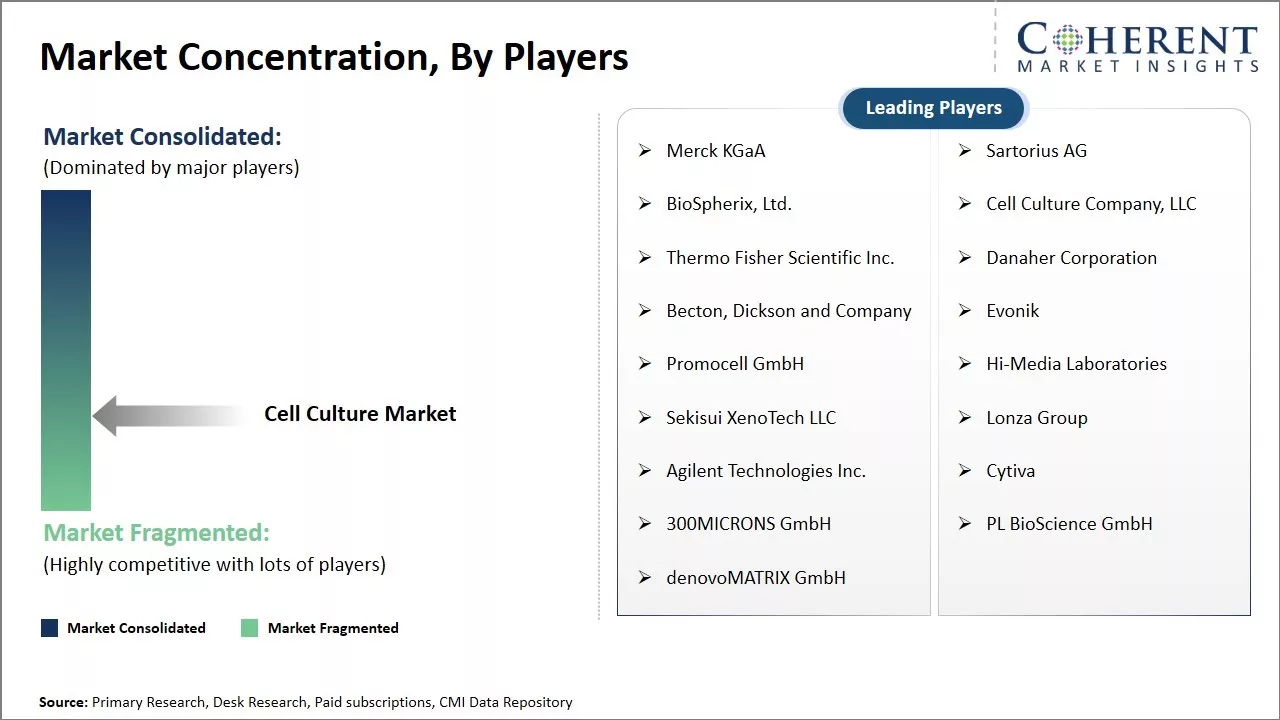
Get actionable strategies to beat competition: Download Free Sample
Increasing adoption of strategies such as acquisitions by major playersIncreasing adoption of inorganic strategies like acquisitions by key players in market are expected to drive the market growth over the forecast period. For instance, on February 1, 2021, Cytiva, acquired Vanrx Pharmasystems, a Canada-based company that makes robotic aseptic filling machines to fill vials, syringes, and cartridges, to increase the production of cell culture and gene therapies.
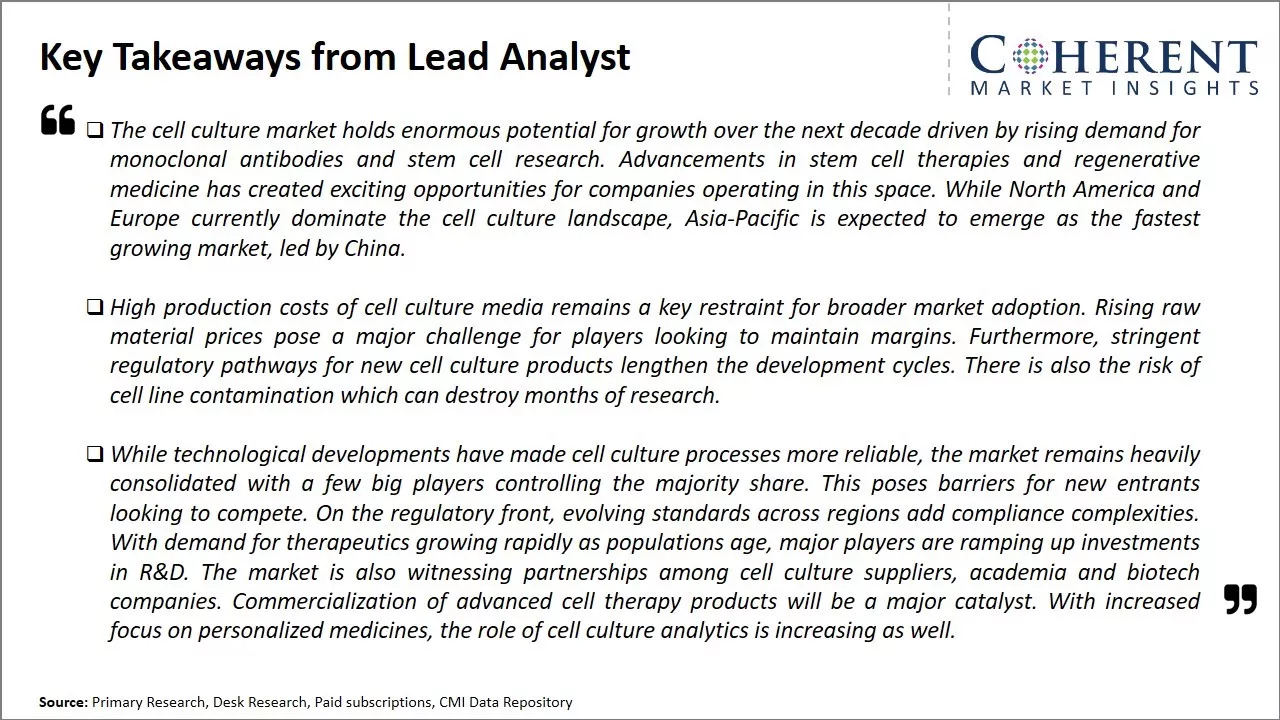
To learn more about this report, Download Free Sample
Market Challenges: High infrastructure and maintenance costsThe cell culture market faces several challenges. High infrastructure and maintenance costs associated with cell culture processes strain budgets for research labs and manufacturers. Maintaining sterile conditions throughout production is also difficult and contamination risks delaying projects. Limited knowledge of 3D cell culture techniques restricts their applications. Understanding cellular behaviors in more complex multi-cellular 3D models remains an obstacle. Reproducibility difficulties due to natural variabilities between primary cell sources challenge progress. Regulations surrounding cell lines derived from human tissue add complexities to sourcing needs.
Market Opportunities: Advent of 3D cell culture technology
The advent of 3D cell culture technology could provide significant opportunities for growth in the cell culture market. 3D cell cultures allow for more complex tissue structures and cell-cell interactions compared to traditional 2D cultures. This increased physiological relevance provides opportunities to better model human disease for improved drug discovery and testing processes. 3D cultures mimic natural tissue architectures much more closely than 2D cultures. Within 3D cultures, cells can organize into multi-cellular spheroids or organoids that resemble natural tissues to a high degree.
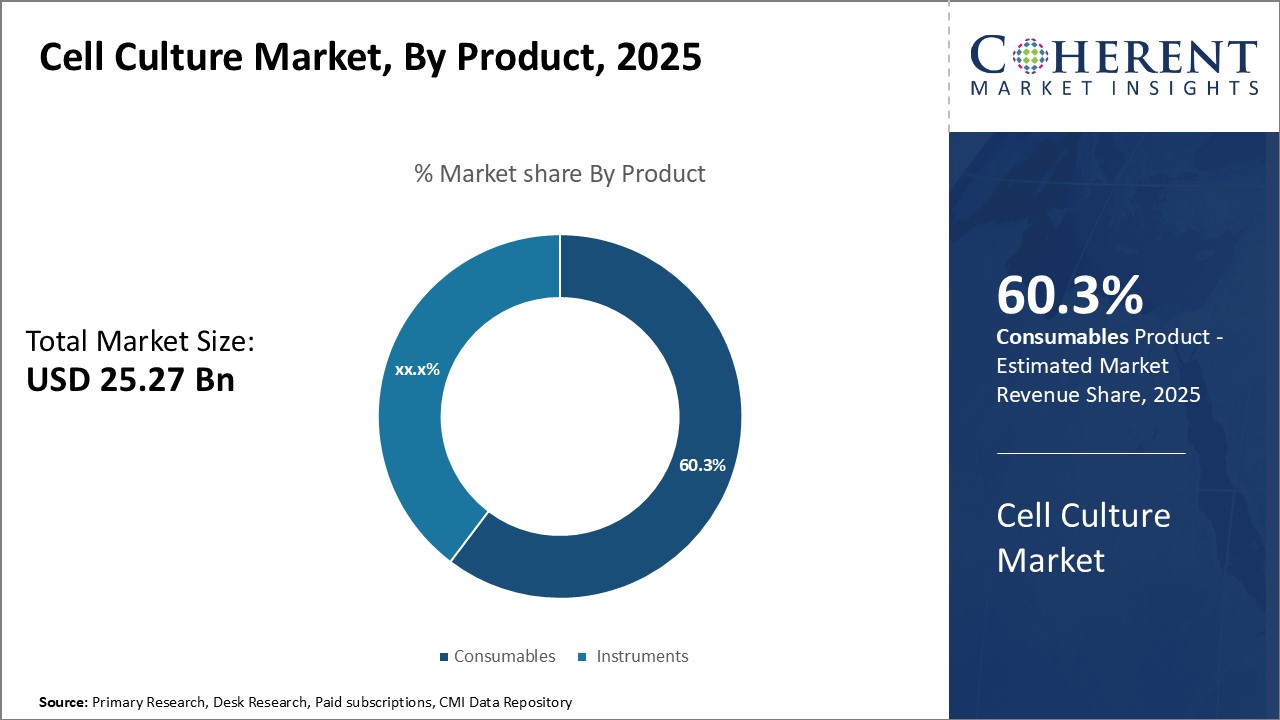
Discover high revenue pocket segments and roadmap to it: Download Free Sample
Insights, By Product: Rise in Research & Development Drives Consumables GrowthThe product segment includes consumables (sera, media, reagents), and instruments (culture systems, cryostorage equipment, and biosafety equipment). Consumables is anticipated to hold 60.3% of the market share in 2025. Cell culture processes require consistent supplies of media, reagents, sera, buffers, and supplements to nurture and sustain cell growth. Since these consumables are expended with each experiment or production batch, their recurrent use makes them more affordable than larger upfront instrument purchases. Furthermore, consumables allow cultured cell maintenance and manipulation at much lower variable expenditures compared to operating equipment. Media and reagents form the foundation for cell culture workflows, providing nutrients and maintaining optimal conditions for cell viability. Their repeated replenishment during routine passage and scale-up drives the bulk of consumables spend. A range of sera containing growth factors and proteins stimulates proliferation, adhesion, and differentiation. Supplements enrich media with hormones, antibiotics, and attachment molecules tailoring formulations for distinct cell types. Buffers help control critical parameters like pH during resuspension, dissociation and cryopreservation. Such specialized yet cost-sensitive supplies account for the lion's share of consumables consumption.
Insights, By Application: High Demand for Antibodies, Vaccines, and Recombinant Proteins
The application segment includes biopharmaceutical production, tissue culture & engineering, toxicity testing, drug development, cell & gene therapy, and others. The biopharmaceutical production is expected to hold 30.1% of the market share in 2025. Mass-manufacturing complex biologics such as antibodies, vaccines and recombinant proteins relies heavily on scalable and robust cultivation systems. Regulatory requirements for characterization and quality control also drive significant process development activities employing cell culture workflows. Most blockbuster drugs are recombinant proteins produced from engineered mammalian expression systems. Achieving gram-per-liter titers essential for commercial-scale production demands intensive optimization of cell lines, feed formulations and bioprocess parameters. Widely-used production systems employ Chinese Hamster Ovary (CHO) and other mammalian cells in stirred-tank, air-lift and perfusion bioreactors handling 100L volumes or more.
Insights, By End User: Extensive Cell Culture Capabilities Drive the Growth of Biopharmaceutical Companies
The end user segment includes biopharmaceutical companies, hospitals & diagnostic laboratories, CMO & CRO, and others. Biopharmaceutical companies contributes the highest share of the cell culture market and is projected to hold 36.8% of the market share in 2025. As the primary developers and manufacturers of cell culture-based products, biopharmaceutical companies comprise the largest end user segment in this market. Whether independently or via contract service providers, these companies leverage extensive cell culture capabilities at various stages across the drug development pipeline. During early research and development, biopharma companies employ cell cultures to identify potential drug targets, assess toxicity and optimize lead candidate selection. Translational medicine initiatives exploring disease pathology mechanisms also rely on primary cell cultures and immortalized cell lines. As programs advance into preclinical and clinical testing, cell-based assays become essential for drug candidate screening, efficacy evaluation and biosimilarity assessment. While Contract Manufacturing Organizations (CMOs), Contract Research Organizations (CROs), and research institutes also utilize cell culture, biopharma end users account for the bulk of demand due to their positioning across the entire R&D and manufacturing value chain. Regulatory expectations of demonstrating product safety and efficacy through non-clinical and clinical data further consolidate biopharmaceutical companies lead in the end user segment.
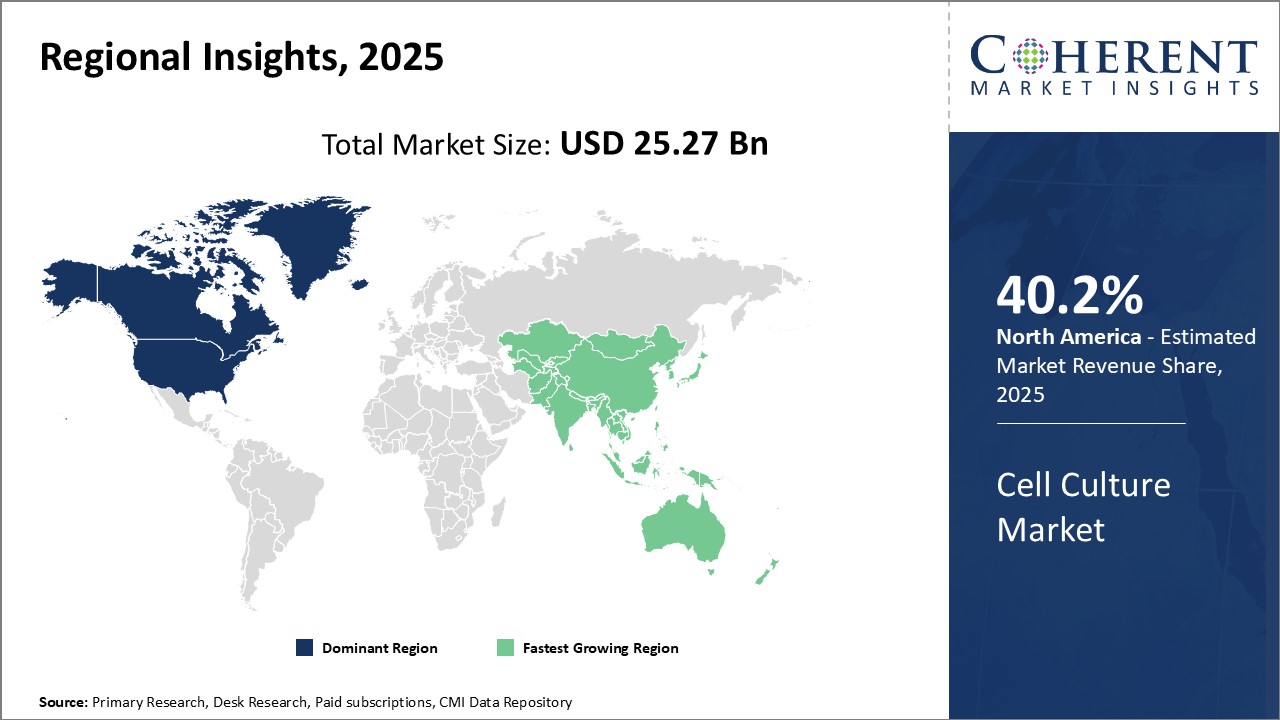
Need a Different Region or Segment? Download Free Sample
North America has established itself as the leading region in the global cell culture market and is expected to hold 40.2% of the market share in 2025. The presence of top pharmaceutical and biotechnology companies in countries like the U.S. has provided a major boost. There is a strong focus on R&D activities related to cell-based research by both private players as well as government institutes. This has led to a massive demand for cell culture equipment, media, and reagents as all new drug development processes now involve extensive cell-based testing. The cell therapy industry is also witnessing rapid growth in the U.S. due to efforts by companies developing new treatment options for chronic diseases. Many global players have set up their cell therapy research centers in North America to gain from the business-friendly environment and access to the talent pool. As more therapies reach the market in the coming years, the North American cell culture market is expected to further strengthen its dominant position.
The Asia Pacific region has emerged as the fastest-growing market for cell culture over the last five years. China, in particular, has emerged as a global force in pharmaceuticals and biologics, with the government focusing on building a robust healthcare ecosystem. Aggressive investments are being made to ramp up domestic R&D and manufacturing capabilities. Countries such as China, India, South Korea, and Singapore are offering attractive incentives to global players to set up facilities. This has led to a surge in infrastructure development for cell-based research. Additionally, the lower costs have prompted many global corporations to outsource certain testing activities to the region. Many biotech startups are also mushrooming with access to risk capital. With its massive population and growing healthcare needs, Asia Pacific's cell culture market is all set to witness exponential growth going forward to meet both the domestic and global demand.
Cell Culture Market Report Coverage
| Report Coverage | Details | ||
|---|---|---|---|
| Base Year: | 2024 | Market Size in 2025: | USD 25.27 Bn |
| Historical Data for: | 2020 To 2024 | Forecast Period: | 2025 To 2032 |
| Forecast Period 2025 to 2032 CAGR: | 12.0% | 2032 Value Projection: | USD 55.90 Bn |
| Geographies covered: |
|
||
| Segments covered: |
|
||
| Companies covered: |
Merck KGaA, Sartorius AG, BioSpherix, Ltd., Cell Culture Company, LLC, Thermo Fisher Scientific Inc., Danaher Corporation, Becton, Dickson and Company, Evonik, Promocell GmbH, Hi-Media Laboratories, Sekisui XenoTech LLC, Lonza Group, Agilent Technologies Inc., Cytiva, 300MICRONS GmbH, PL BioScience GmbH, and denovoMATRIX GmbH |
||
| Growth Drivers: |
|
||
| Restraints & Challenges: |
|
||
Uncover macros and micros vetted on 75+ parameters: Get instant access to report
Share
Share
About Author
Nikhilesh Ravindra Patel is a Senior Consultant with over 8 years of consulting experience. He excels in market estimations, market insights, and identifying trends and opportunities. His deep understanding of the market dynamics and ability to pinpoint growth areas make him an invaluable asset in guiding clients toward informed business decisions. He plays a instrumental role in providing market intelligence, business intelligence, and competitive intelligence services through the reports.
Missing comfort of reading report in your local language? Find your preferred language :
Transform your Strategy with Exclusive Trending Reports :
Frequently Asked Questions
Joining thousands of companies around the world committed to making the Excellent Business Solutions.
View All Our Clients